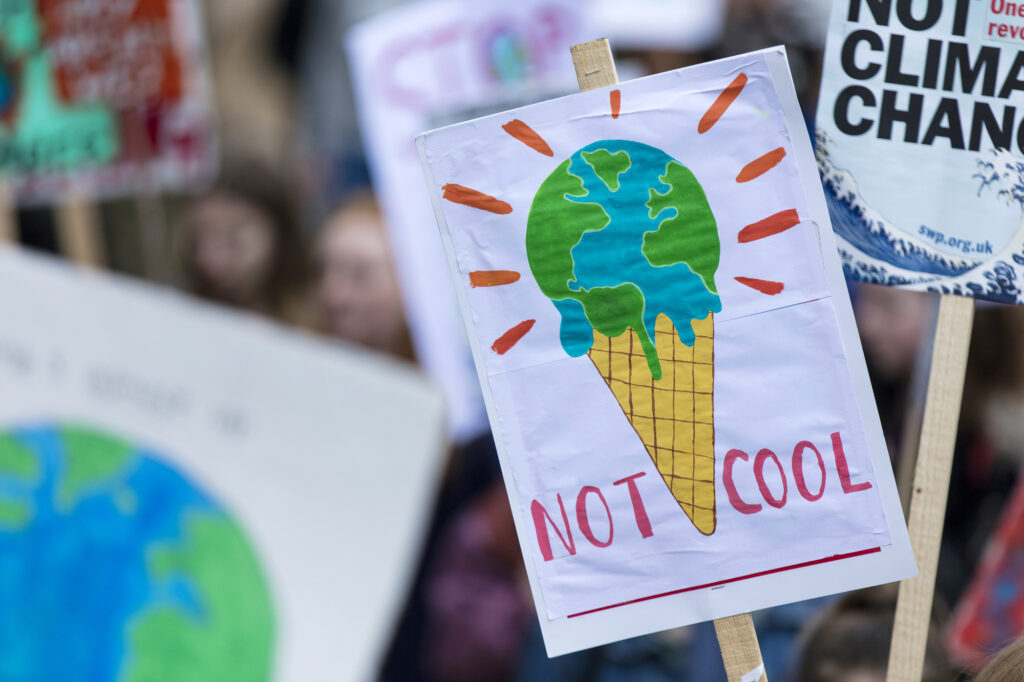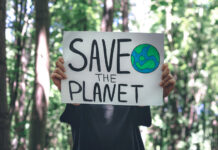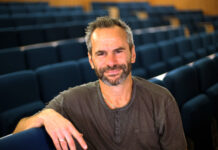The world’s most prominent health organizations, medical associations, and health science journals are unequivocal: the climate crisis poses grave threats to public health, including mental health. But what exactly is the relationship between planetary heating and individual mental health? And what role can mental health care providers play in confronting the climate emergency and its associated human and ecological crises?

Tasked as we are with attending to human suffering, mental health clinicians ought to develop a nuanced understanding of distress related to the climate crisis, one that recognizes people’s fear, sadness, pain, outrage, or horror as normal human responses to the calamitous and upsetting events happening around us—events, it should be noted, which are not natural facts or laws but are, rather, products of the decisions by dishonest, greedy fossil fuel executives and their political allies who refuse to reign in harmful pollution and extractivism.
The maxim that “capitalism makes us sick” will be a familiar one for Mad in America readers, and it is no different in the context of climate-related mental distress. Our responses to this sick system must therefore extend beyond focusing on individuals who suffer and instead out into the domains of community, politics, systems, and the “rapid, far-reaching and unprecedented changes in all aspects of society” that the Intergovernmental Panel on Climate Change has said are required to limit global warming to 1.5°C.
But how should we understand “climate distress” in the first place—or however we might call what emerges from our awareness of ever-increasing global heating, mass extinction events, and other existential threats to the world and its biodiversity? A handful of models may be particularly helpful for deepening our understanding, including ecological grief, described by researcher Ashlee Cunsolo; existential distress, as articulated in the fields of psychosocial oncology and palliative care; and pain for the world, the conceptual framework developed by Buddhist scholar and eco-philosopher Joanna Macy.
For therapists who might encounter individual-level climate distress, familiarity with these models will help them reject the false burden borne by individuals and embrace instead a spirit of shared vulnerability, solidarity, collective action, and demands for justice.
Models of Climate Distress
Grief is a normal, universal human response to loss – an internal, physiological experience tied to deeply painful emotions including sadness, anger, and others. Canadian researcher Ashlee Cunsolo’s concept of ecological grief is unique in its qualities of disenfranchisement (i.e., grief that is not openly acknowledged) and ambiguity (i.e., grief that is difficult to identify or articulate). Ecological grief is also distinct from more conventional forms of grief in that the losses are vague, often non-human, and their boundaries and trajectories are ill-defined. In addition to objective losses such as meaningful species, landscapes, and entire ecosystems, we are also mourning our perceived loss of safety and our hope for a secure, knowable future.
The utility of this model comes in our response to grief. For Cunsolo, grief and its associated process of mourning (i.e., the period of transition we go through following a loss) have “we-creating capacities”. The recognition of this form of distress, then, opens possibilities for connection to others, which serves the dual benefits of universality and broad, reciprocal validation (“I see you, and we are in this together”) along with opportunities for collective action in response to the unfolding threats.
Naming collective ecological grief also allows for the important work of mourning past and inevitable losses while looking towards the future to prevent or mitigate anticipated losses that are not yet certain. And at the individual level, attending to and deepening the experience of ecological grief also invites the recognition that grief is an expression of love—that which is deeply felt for others who are gone or suffering, or for the world more broadly. Viewed this way, our grief can invite a renewed connection to the natural world, which may strengthen the drive to engage with others in work towards required systems-level change.
Next, in the fields of psychosocial oncology and palliative care, existential distress is considered a distinct, painful psychological state, which, per researchers Sigrun Vehling and David Kissane, results from a stressor which “challenges fundamental expectations about security, interrelatedness with others, justness, controllability, certainty, and hope for a long and fruitful life.” In the context of cancer care, this stressor could be a diagnosis with a life-threatening illness or learning of disease recurrence or progression. The unfolding planetary crises we now face surely satisfy the criteria for such a stressor, and the popularity of writers such as David Wallace-Wells, Elizabeth Kolbert, and Roy Scranton, whose work covers these far-reaching concerns, speaks to the resonance of existential distress for many, even if it is not named as such.
Existential distress may be experienced as a flood of distressing emotions, including fear, outrage, and horror at the possibility of death; a sense of loneliness, hopelessness, or meaninglessness; grief and regret; and others. These emotions also relate to a separate construct in psychosocial oncology and palliative care: demoralization, which is characterized by feelings of helplessness and pointlessness, the perception that the future is not worthwhile, and a sense that present circumstances or predicaments are outside of our control, intractable—a set of statements I’d wager are common, however fleeting or persistent, for people distressed by the prospect of climate disaster.
Existential distress as a construct in psychosocial oncology and palliative care is rooted in existential psychotherapy, which concerns itself with, as psychiatrist Irvin Yalom puts it, the four “ultimate concerns of life”: death, freedom, existential isolation, and meaninglessness. It is also related to psychiatrist and philosopher Karl Jaspers’s “Limit Situations”, defined as moments in which the proverbial rug is pulled from beneath our feet, and with it our sense of security. These moments may be accompanied by experiences of dread, anxiety, or guilt, and the existential blindfold they remove creates a situation which is “unbearable for life”, leaving the person experiencing them with the choice to either face them (providing the opportunity for an “upswing”—an expansion of horizons and experiential possibilities) or to deny or avoid them, leading to paralysis.
For Joanna Macy, however, the emotions tied to our awareness that “we have lost the certainty that there will be a future for humans” cannot be equated with ordinary existential concerns. Macy understands climate-related distress as pain for the world, which she views as a normal, healthy response to a world in trauma—a formulation she develops beautifully in her recently-reissued 1991 book World as Lover, World as Self.
Our emotional response to the unfolding threats should be understood as adaptive—pain is, after all, an evolutionarily-honed warning signal “not to be banished by injections of optimism or sermons on ‘positive thinking’, [but rather] to be named and validated as a healthy, normal human response.” This formulation grants the sufferer the permission to feel—a bold act which is, in the face of overwhelming despair, grief, or existential distress, in and of itself therapeutic. As Macy points out, “the refusal to feel takes a heavy toll [that] only impoverishes our emotional and sensory life.”
Importantly, Macy ties this fear, refusal to feel, or disavowal to the austerity-driven inadequacies in the social safety net which are driven by capitalist forces. When our focus narrows to immediate survival needs, we cannot maintain awareness of what is transpiring around us, much less name or feel the emotions associated with broader, collective concerns like the climate crisis.
This same, narrow focus on survival needs is also informed by the neoliberal logic that it is the individual who is at fault for their precarity, not the political and economic structures that created the conditions responsible for it. In turn, this logic informs the malignant individualism knowingly or implicitly endorsed by some therapists who attempt to locate sources of distress within a “broken” or disturbed individual—dismissing or diminishing the conditions that shape clients’ lives outside of the office. The downloading of societal ills to the individual clearly has implications at the clinical level.
Capitalism and Climate Distress
Psychological suffering may be understood as a “downstream” signal that often results from a complex causal pathway with powerful “upstream” determinants. Mental health professionals are unfortunately well-versed in responding to individual-level consequences of failed or inadequate social policy. Interventions that would best serve people and the public good, including social programs such as universal healthcare, pharmacare, and even further upstream initiatives such as social welfare, are often stymied by insufficient public revenue and resource constraints. This is a cold reality, we are told, while the private sector, including the fossil fuel industry, reaps ever more profits.
Here in Canada, the privatization of many natural resources, especially oil and gas, has resulted in near-total political deference to the industry’s interests. Canada’s federal government dedicated $18 billion to assist the oil and gas sector (or 18% of its total COVID-19 stimulus expenditures to date). This system of governance where corporate subsidies—a form of private welfare—go unquestioned while public programs struggle under the mounting pressures of austerity has fostered a punishing culture where the burden of responsibility to address upstream sources of distress and dysfunction is shifted from politicians and employers onto those who suffer the downstream consequences.
In the fight against the climate crisis, the oil industry and its aggressive lobby have much to gain by preaching the power of individual action. We are encouraged to buy local, switch to eco-friendly laundry detergent, invest in “zero waste starter kits”, and are even cautioned against having children to reduce our carbon footprint. Indeed, the very concept of a “carbon footprint” was aggressively promoted by British Petroleum while the company and its counterparts continued their unfettered and calamitous fossil fuel extraction to satisfy their profit motives. Just 100 companies are responsible for 71% of total global carbon emissions.
Narratives of individual responsibility for the climate crisis are not only empirically misguided, they also obscure the responsibility and power of those who can effect meaningful systems-level change. We must acknowledge that this disconnection, and the despair borne by ordinary people in its face, are the result of the exploitation and injustice wrought by capitalist social and economic systems.
Therapeutic Approaches
If we accept the likelihood that some people will experience normal, yet still very painful climate-related emotional distress, there follows the possibility that a set of these people may seek a therapist to help them cope with difficult feelings or to better understand their experience. Those already engaged in supportive relationships with professional mental health clinicians may also process climate-related distress during their work. Of course, some may also share their feelings and concerns with like-minded others in non-clinical settings, such as “Ecological Grief Circles”, or in activist spaces, like those offered by Extinction Rebellion. But when such concerns do arise in clinical work, how should a therapist respond? And how should they navigate the political and psychological risks related to individualizing climate despair while also honouring the real struggles that individuals do experience?
Having presented a structural analysis of climate distress, it is tempting to suggest that clinicians simply concern themselves with politics or activism. Perhaps an individual care provider can effect more change or good via work at the level of systems than in work with individual clients. At the very least, a deep familiarity with the social, economic, and cultural context—the structural determinants of health—is a necessary starting point for therapeutic work. However, it is not sufficient.
Mental health clinicians serve a “suffering Other” who is unlikely to be satisfied or relieved by our pointing to a set of complex upstream factors, or even a demonstration of our efforts to combat various forms of injustice which may be contributing to their predicament. Action at systems levels by an informed, compassionate care provider may offer unfortunately little to their distressed patient in any given clinical encounter. Relatedly, developing a nuanced clinical approach to problems with clear upstream determinants need not represent an acceptance of a toxic sociopolitical status quo.
Painful or challenging emotions such as fear, anxiety, sadness, despair, frustration, anger, guilt, and others are universal, evolutionarily-engrained, and, when tolerable and accessible to the person experiencing them, can be useful in the service of growth, healing, and action. This is true whether these emotions occur in the course of day-to-day relationships, emerge from painful memories, or result from our awareness of the existential threats of climate change. I do not wish to fetishize such emotions or the potentially devastating or traumatic experiences that can give rise to them, but I will suggest that our attunement to suffering—both our own and that of others around us, near and far—is to be appreciated as a sign of strength. Pain and upset in response to painful and upsetting situations may be both perfectly normal and a sign of healthy, mature emotional functioning.
A former psychosocial oncology supervisor of mine often shares a similar refrain when meeting with a new patient or family devastated by the news of advanced cancer, or of non-response to treatment: “you’re experiencing a perfectly normal set of feelings in response to a highly abnormal situation.” Here we see the tremendous power of validation—the witnessing from another that I’m not crazy.
The same orientation for mental health providers in the face of climate-related distress is therefore critical: one that is normalizing, validating, and which is followed by an invitation to open up, wholly sink into and experience the distress. This is a radical act which is likely to be accepted only by a patient or client who encounters a therapist prepared to forgo diagnostic labels and symptom reduction, and instead willing to witness, to hold, or better yet, to accompany people in their suffering. It is here that people can best engage in a process of mutual sense-making, or where, paradoxically, peace in suffering may be encountered.
But is equanimity in the face of a burning world really what we’re after? In Macy’s language, through a clear-eyed engagement with suffering, or rather through an intentional facing to the flow of one’s emotional experience, a weight lifts, a “turning” can occur, and with it, a renewed appetite for life, and even, perhaps, a heightened determination to act. As she says, “[this work] involves nothing more mysterious than telling the truth about what we see and know and feel is happening to our world.” The importance of facing—or indeed working through—challenging emotions and experiences, as opposed to disavowing or suppressing them, is central to the work in therapy (or the individual work) that follows from all three models of climate distress presented above (ecological grief, existential distress, and pain for the world).
Individual Therapy for a Societal Problem
Mental health providers do not have the greatest potential, nor do we bear sole responsibility, for mitigating the distress of our patients or the population at large in relation to the climate crisis. Enacting policies which serve to rapidly decarbonize, to protect vulnerable communities, and to otherwise act in a way commensurate with the urgent and dire threats facing us is far likelier to achieve that aim.
And while climate-related threats are, in a sense, universal, it is important to note that their impacts are unevenly distributed, with grossly disproportionate impacts on the structurally vulnerable. Threats of personal annihilation or even genocide are also not new for many. This acknowledgement is not to weigh the gravity of such threats against one another, nor to compare the experiences of those who lived through or continue to endure them. Rather, if it is true that “people who had been insulated from oppression are now waking up to the prospect of their own unlivable future”, we must work to ensure that the recognition of shared vulnerability leads to solidarity; that whatever follows from our awareness of the intersecting crises of our time resists all turns towards isolationism, nationalism, and ecofascism; and that our collective responses embrace instead a broad understanding and efforts in service of justice.
Accordingly, health professionals and others who attend to psychological suffering must concern ourselves with the social, economic, and social determinants of health through advocacy, active engagement with justice-oriented political campaigns, and participation in grassroots/movement-based organizing, including mass actions of non-violent social protest.
The role of mental health professionals in responding to the climate crisis may therefore be twofold: at the clinical level, to adopt an approach to individual suffering that rejects false notions of individual “brokenness” and instead honours people’s grief, existential distress, or pain for the world as normal, healthy responses to a profoundly abnormal situation. And secondly—and more importantly—we must work beyond the “consulting room” to join with others in meaningfully addressing the upstream/structural drivers of climate-related distress and building more just, equitable, and sustainable communities for all.















Thanks for this post, it is a very important topic, one that often flies a bit “under the radar” of what people usually notice and think about.
One tricky bit of it has to do with the “individual responsibility” thing. I agree that this can be over-emphasized, and lead to ignoring the more systemic and central issues, but I think individual responsibility can also be under-emphasized, leading to people for example berating the big companies that sell them fossil fuels while they fill up their gas guzzler and then head to the airport to use more fuel to jet around the world.
We live in a society where people are on average quite poor at taking individual responsibility for doing their share to solve collective problems. We struggle to address even the most simple of these, as when people don’t want to wear a mask or get immunized to do their share to protect others. Therapists, who are used to helping people find ways to not feel bad, are sometimes too quick to help people not feel any burden to care for others, and that can be part of the problem.
Report comment
I can’t relate to this article. Why should therapists be more concerned about climate distress than other social distresses? How about too many people in the world distress, too much crime distress, poverty distress, inequality distress, too high inflation distress, too many wars distress, abortion restriction distress. I can go on.
Therapy should deal with personal distress, like I have a serious illness I can’t get along with my wife, my children are failing in school, I’m depressed, I’m being persecuted.
If a person is only upset about climate change, they shouldn’t go to a therapist. Become an activist if you want, change what you can, accept what you can’t change. As for therapists, let them decide what social issues they want to get involved in, if any; maybe it won’t be climate change. There are plenty of other challenges we face.
Report comment
Step #1: TURN OFF THE TELEVISION(and newspapers and push news media online.) Climate anxiety is caused by years of 24/7 fearmongering- not for the purpose of change, but for the purpose of keeping people tuned in an in a manipulable emotionally aroused state. BEING TOLD THE WORLD IS ENDING EVERY DAY WHEN IT ISNT, and believing it, makes you anxious! And that keeps you clicking and watching ads and absorbing promoted narratives.
Step #2: the least powerful people in society need to reject the mainstream narrative that climate change is their fault or their personal responsibility to fix. It is not normal to feel shame about eating meat, owning a car, taking a shower etc because an international corporation is dumping smog into the atmosphere, draining an aquifer to make bottled water etc. That is a narrative constructed as a smokescreen by the powerful to avoid being held accountable for their actions.
These distortions and the guilt, shame and anxiety they cause can all be remedied with therapy.
Report comment
Hmmm, ignoring messages about what’s happening is certainly and instant mood improver, but my sense is in the longer term it only works if the messages one is getting are false or exaggerated, it doesn’t work so well when the message is true. And my read is that the media actually are doing a terrible job of informing people about the threat of global warming: the media likes to focus on threats at are about tomorrow or next week or next month, and climate change isn’t like that. But when people do wake up anyway to the fact that we are making the planet incapable of supporting human civilization and stable ecosystems for our kids and grandkids, they do have an emotional reaction, and at a certain point playing “let’s pretend it isn’t happening” doesn’t work anymore. We do need to collectively figure out how to handle facing the reality without entering unhelpful mental states.
Report comment
SO glad to see your comment!! THIS is the only way to cure: ASK QUESTIONS!!! Anyone by now should realize this climate change alarmism is not based on true science whatsoever, and is of the same ilk as the covid 19 fear mongering! All the same players are involved too. I was very into researching all about this before the dreadful 2020/21 began. It is all FEAR PORN. They basically admit it if you understand this climate change none~sense is the plan coming from the Club of Rome!
John Coleman of KUSI: How the Global Warming Scare Began https://www.youtube.com/watch?v=7P5RW0Tmp-U
FOUR CLIMATE SCIENTISTS DESTROY THE GLOBAL WARMING-MYTH IN MINUTES. https://www.bitchute.com/video/nLAfO2MnNjPO/
COVID 19 IS NOT ABOUT A VIRUS – IT’S ABOUT ECONOMIC RESET & GLOBAL WARMING: THE WHO
https://www.youtube.com/watch?v=a0MKuNH-eSc
Report comment